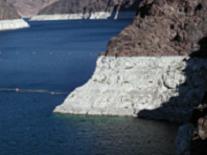Peace on the Colorado River?
Colorado River Basin Water Short Agreement accord
LeRoy W. Hooton, Jr., Director Salt Lake City Department of Public Utilities
December 30, 2006
|
The message behind the term is that the Seven States are united in their desire to make the agreement work and buy peace while measures are taken to enhance the water available under the 1922 compact. Some rate the agreement as important as the compact. “This is a critical time, perhaps even an historic time,” said new Interior Secretary Dirk Kempthorne.
Last January, responding to a request of Secretary Norton, the Seven States submitted a proposed shortage agreement to the Bureau of Reclamation. The urgency of this agreement was brought about by 5 years of drought, which caused the water levels in Powell and Mead to plunge. Lake Powell dropped 117 feet below pool level. Under worse conditions it was projected that hydropower production could cease in 2006. Fortunately 2005 was a wet year and both declining Powell and Mead water levels slightly rebounded. Lake Powell capacity increase from a low 49 percent to 51 percent. The states’ proposed agreement recommended among other things a coordinated operation of Powell and Mead reservoirs, conservation measures and augmentation of the water supplies in the basin.
A draft EIS on the proposed shortage agreement is expected to be out in February. The states believe it’s in their best interest to have a unified position with the federal government in preparing and obtaining the final decision on the EIS. Key to this is cooperation, collaboration and avoiding litigation. The goal is to have the process completed by end of 2007.
The basic problem said Lower Basin representative from Arizona Herb Gunther, “There’s not enough water to support new development. We need to replenish the river during periods of shortages; the Colorado River will not satisfy the growing needs of the West.” The recent drought came close to creating a drought related water shortage crisis, and population growth is no small problem. The nation’s population just reached 300 million and according to census data the Southwest has grown at a rate 6.6 times faster than the nation as a whole during the 20th century. There is no evidence that this trend will abate and this region of the US will continue to grow at a disproportional rate.
The shortage agreement provides benefits to both the Upper and Lower Basin states. “The merit of the agreement is acknowledgement that the Upper Basin states are entitled to their water under the compact,” said New Mexico executive director of the Interstate Stream Commissioner Estevan Lopez. Colorado Upper Colorado River Commission Scott Balcomb noted that the Upper Basin is better off with a deal in order to develop its water into the future. Both views were reinforced by D. Larry Anderson, retired Utah Water Resource Director, adding that this will give Utah time to develop its share of the Colorado River allocation. He alluded to the Lake Powell pipeline to St. George. All agreed that they wanted to avoid litigation and allowing the courts’ to decide issues on the Colorado River.
Likewise, Lower Basin speakers agreed that the states needed to cooperate and find solutions. Southern Nevada Water Authority general manager Pat Mulroy said that the states have been and will continue to be together in dealing with the issues facing the states. She said in regards to augmentations, new water supplies will have to come from outside the basin – within our own county and in Mexico. She said that the challenges of tomorrow will be more daunting than in the past. “To all of those who have gotten us to where we are today, Nevada thanks you,” she said.
In regards to Mexico, Mulroy stated that it’s inevitable that a much larger conversation must be started in the county of Mexico. “The difficulty in sending water across the border, it’s used for agriculture and never reaches the Delta, said Mulroy, adding she was optimistic that there are opportunities for solutions.
Not only are the operations of the reservoirs on the table, but a bevy of other issues, such as augmentation, forbearance, and the Mexican Treaty. Other stakeholders including the environmental community, Indian tribes, recreation and power interest reminded the states’ that they had to be included in the process. Being left out will invite litigation said environmentalist Jennifer Pitt of the Environmental Defense, who urge inclusion in the decision making process.
A key element of the shortage agreement is augmentation to the river system. A study has been commissioned to determine the feasibility of various augmentation options. According to Colorado River water consultant project manager Les Lampe there are over 20 options being studied, ranging from urban water conservation, conjunctive water use, ocean desalination, vegetation management, water reuse, weather modification, water import using ocean routes, pipes – barges and water transfers from agriculture to urban use to mention a few.
In addition, a resolution was passed by CRWUA requesting that the Bureau of Reclamation consider the effects of global warming on the Colorado River.
Interior Secretary Kempthorne urged the parties to continue to make progress in developing the shortage agreement. “If we are wise, future generations will benefit. If we are unwise, future generations will suffer. It’s incumbent upon us to be wise,” he said.
